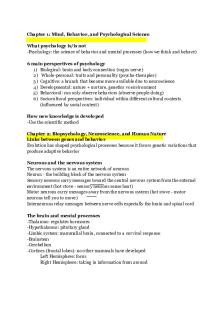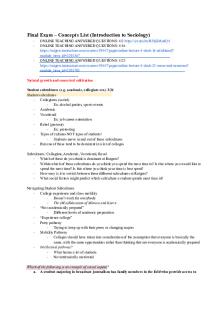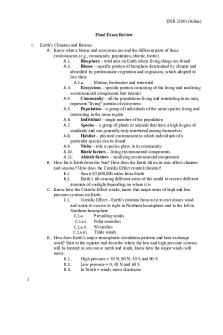Intro to Psych Final Exam Study Guide PDF

| Title | Intro to Psych Final Exam Study Guide |
|---|---|
| Course | Educational Psychology |
| Institution | Notre Dame de Namur University |
| Pages | 8 |
| File Size | 161.2 KB |
| File Type | |
| Total Downloads | 39 |
| Total Views | 143 |
Summary
Download Intro to Psych Final Exam Study Guide PDF
Description
Chapter 1: Mind, Behavior, and Psychological Science What psychology is/is not -Psychology: the science of behavior and mental processes (how we think and behave) 6 main perspectives of psychology 1) Biological: brain and body connection (vagus nerve) 2) Whole-personal: traits and personality (psycho-therapies) 3) Cognitive: a branch that became more available due to neuroscience 4) Developmental: nature + nurture, genetics vs environment 5) Behavioral: can only observe behaviors (observe people doing) 6) Sociocultural perspectives: individual within different cultural contexts (influenced by social context) How new knowledge is developed -Use the scientific method Chapter 2: Biopsychology, Neuroscience, and Human Nature Links between genes and behavior Evolution has shaped psychological processes because it favors genetic variations that produce adaptive behavior Neurons and the nervous system The nervous system is an entire network of neurons Neuron - the building block of the nervous system Sensory neurons carry messages toward the central nervous system from the external environment (hot stove - sensory neurons sense heat) Motor neurons carry messages away from the nervous system (hot stove - motor neurons tell you to move) Interneurons relay messages between nerve cells especially the brain and spinal cord The brain and mental processes -Thalamus: regulates hormones -Hypothalamus: pituitary gland -Limbic system: mammalial brain, connected to a survival response -Brainstem -Cerebellum -Cortices (frontal lobes): no other mammals have developed Left Hemisphere: focus Right Hemisphere: taking in information from around
Chapter 3: Stimulation vs sensation Stimulation: any object or event that triggers a sensory response Sensation: process when stimulated receptors create stimulus in the brain, creating our experiences with each and every stimulation What are the 5 senses? 1) Sight 2) Smell 3) Touch 4) Taste 5) Hearing Sensation vs. perception Perception: how we interpret and make meaning from what we have sensed Chapter 4: Learning and Human Nurture Classical conditioning Ivan Pavolov: demonstrated stimulus generalization on dogs nad studied discrimination learning Little Albert: conditioned to fear furry objects Operant conditioning Skinner’s radical behaviorism 1) Law of effect The power of enforcement 1) Food, money, sex - strengthens a response making behavior more likely to occur again Positive reinforcer: add something to reinforce the desired behavior, take away to increase desired behavior (eat vegetables to get dessert) Noncognitive psychology explains learning -long term potentiation: strengthen the synapses in groups of nerve cells -insight learning with chimps: suddenly you get insight -cognitive maps: visualize where we are in space Chapter 5:
What is the memory? A mental image of some sort that you can -Memory’s 3 basic tasks How do we form memories? -Sensory -Working -Long-term How we retrieve memories -Implicit and explicit memory -Retrieval cues -Other factors that affect retrieval Failures of memory -Transience -Absent - pointless -Blocking -Bias -MSuggestibility -Memory’s seven sins Chapter 6: Components of thought Thinking is a cognitive process in which the brain uses emotions and memory to create and manipulate mental represent such as concept, images, and scripts → incorporating emotions and memory Abilities good thinkers passes -Have effective strategies such as algorithms and heuristics -Avoid common impediments to problem-solving/decision making Multiple intelligences Some psychologists believe that intelligence is one factor, but other psychologists believe it is a collection of abilities Chapter 7: Innate abilities of infants
Newborns have innate abilities for finding nourishment, avoiding harmful situations, and interacting with others 1) Innate reflex: grasping, sucking, arching, swimming, hearing, mimicry, vision last to be developed Developmental tasks of childhood -Nature and nurture work together to help children master developmental tasks 1) Increase attention spam 2) Working memory 3) Language acquisition 4) Cognitive development 5) Development of social relationships 6) Gender identity Changes during adolescence 1) Frontal cortex: continue to develop 2) Sense of identity becoming more stable 3) Moral reasoning 4) Sexual orientation Developmental challenges of adults 1) Emerging adulthood: not quite in adulthood yet, not financially independent 2) Middle adulthood: having families 3) Later adulthood: finding meaning, legacy? Chapter 8: Consciousness vs. nonconsciousness -Individual awareness of own thoughts, memories, feelings, sensational, and environment - constantly changing -Any brain process that does not involve conscious processing - walking, chewing gum, and breathe simultaneously Cycles of everyday consciousness’ Sleep: circadian rhythm: sleep debt Seep in 90-minute cycles: REM and non-REM REM: accompanied by sleep paralysis Disorders of sleep 1) Narcolepsy 2) Sleep talking 3) Insomnia 4) Bedwetting 5) Sleep apnea
6) Sleepwalking 7) Night terrors Other forms of consciousness -Altered states of consciousness included hypnosis, meditation, and psychoactive drug states -Modified by mental, behavioral, or chemical means Chapter 9: What motivates us? Intrinsic and extrinsic motivation occur when our behavior is driven by reward either internally or externally Theories of motivation Instinct: biological process that motivate behavior Drive: need produces drive until drives are reduced Hunger and sexual motivators Both motivators, you can live without sex but cannot live without eating Hunger - disrupting homeostatic system Fulfill the need by eating food, produces the drive Emotions as motivators Help us to respond to communicate our intentions What controls our emotions Activated by limbic system: survival system Left side: Positive emotions reside Amygdala: (part of limbic) Hippocampus: seat of new memories (part of limbic) Chapter 10: Forces that shape our personalities Biology and evolution Personality and development Nature and environment Social networks and culture Components that make up a personality
Dispositional theories suggest a small set of personality characteristics, known as temperaments, traits, or types that provide consistency to the individual's personality over time Theories of personality An attempt of explaining behavior, including how different types of behavior occur. Theories fall into 4 types: psychoanalytic, humanistic, trait, and social cognitive -The big 5: 5 essential, universal traits to personality, consist over time Chapter 11: How social behaviors affect our behavior Often conform to the norms of a group to gain acceptance What influences our judgments of others Reward theory of attraction Similarity principle How systems create situations that influence behaviors System power (Stanford prison experiment, Abu Ghraid prison, bullying) Chapter 12: What is a psychological disorder? The medical model views psychological disorders as “diseases” but psychological view views them as the interaction of biological, behavioral, cognitive, developmental and social factors → Symptoms look different based on social and cultural factors Classifications of a disorder (DSM) Most widely used system for classifying mental disorders and organizes them by their mental and behavioral symptoms -Mood disorders -Anxiety disorders -Somatoform disorders -Developmental disorders -Adjustment disorders Consequences of labeling people -Self-esteem (with someone with a mental illness; person-first language) -The way they get treated
-”Different” -The way they’re thought of -Ignore social/cultural context in which problems arise -Depersonalization Chapter 13: Components of therapy Focused on improving a person’s mental behavior or social functioning -Therapeutic alliance and having goals, empathy, positive regard Types/Categories of therapies 1. Behavior Therapies 2. Psychodynamic Therapies: discuss dreams because of the symbolic dream 3. Humanistic Therapies 4. Cognitive Therapies 5. Group Therapies 6. Biomedical Therapies 7. Creative arts therapies Biomedical Approach -Use of medications and other medical treatments -Drug therapy -Psychosurgery (RARE) -Electroconvulsive -Transcranial magnetic stimulations Which works better, why? -Combination of psychological + medical therapies (show much more efficacy with anxiety, major depressive disorder) or psychological treatment alone Chapter 14: Causes of distress -Stress: state, Stressor: external stimulus that causes distress in an organism/individual -Interpersonal reaction to problems such as conflicts, illness, death of a loved one, divorce -Environmental adjustments -Anxiety
-Depression Physical effects of stress -Low energy -Headaches -Upset stomach -Chest pain/rapid heart beat -Insomnia -Lack of sexual desire Transforming stress into positive life strategies -Avoid unnecessary stress -Adapting to the stressor (optimism) -Accept the things you cannot change but work to change the things they can Components of wellbeing -Positive outlook and resilience, things we can do to increase our wellbeing: sleep more, nutritious diet, meditation, drink water, exercise, social networking...
Similar Free PDFs

Intro To Psych Final Exam
- 24 Pages

Study Guide Psych Final
- 20 Pages

Psych final study guide
- 11 Pages

Intro to psych exam notes
- 32 Pages

Psych Final Study Guide
- 18 Pages

Psych 101 Final Exam Study Guide
- 5 Pages

Intro to Biology Exam 2 study guide
- 11 Pages

Psych 101 Final Exam Study Guide
- 36 Pages

Psych 100 Final Exam Study Guide
- 20 Pages

Intro to Stats Final Study Guide
- 15 Pages
Popular Institutions
- Tinajero National High School - Annex
- Politeknik Caltex Riau
- Yokohama City University
- SGT University
- University of Al-Qadisiyah
- Divine Word College of Vigan
- Techniek College Rotterdam
- Universidade de Santiago
- Universiti Teknologi MARA Cawangan Johor Kampus Pasir Gudang
- Poltekkes Kemenkes Yogyakarta
- Baguio City National High School
- Colegio san marcos
- preparatoria uno
- Centro de Bachillerato Tecnológico Industrial y de Servicios No. 107
- Dalian Maritime University
- Quang Trung Secondary School
- Colegio Tecnológico en Informática
- Corporación Regional de Educación Superior
- Grupo CEDVA
- Dar Al Uloom University
- Centro de Estudios Preuniversitarios de la Universidad Nacional de Ingeniería
- 上智大学
- Aakash International School, Nuna Majara
- San Felipe Neri Catholic School
- Kang Chiao International School - New Taipei City
- Misamis Occidental National High School
- Institución Educativa Escuela Normal Juan Ladrilleros
- Kolehiyo ng Pantukan
- Batanes State College
- Instituto Continental
- Sekolah Menengah Kejuruan Kesehatan Kaltara (Tarakan)
- Colegio de La Inmaculada Concepcion - Cebu





